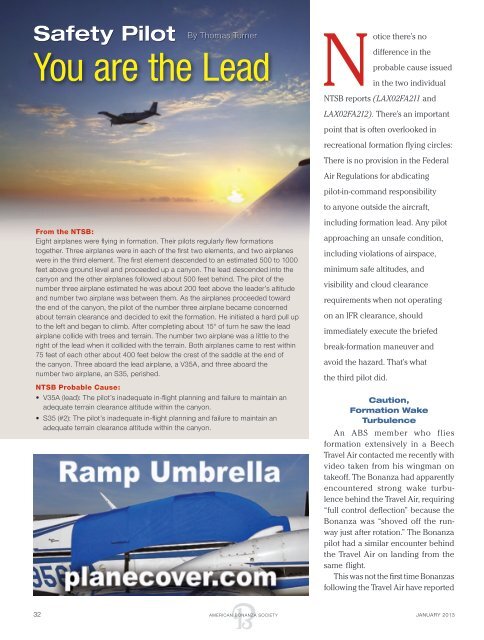Insurance Discount May Pay for Your BPPP Training - American ...
Insurance Discount May Pay for Your BPPP Training - American ...
Insurance Discount May Pay for Your BPPP Training - American ...
You also want an ePaper? Increase the reach of your titles
YUMPU automatically turns print PDFs into web optimized ePapers that Google loves.
Safety Pilot<br />
By Thomas Turner<br />
You are the Lead<br />
From the NTSB:<br />
Eight airplanes were flying in <strong>for</strong>mation. Their pilots regularly flew <strong>for</strong>mations<br />
together. Three airplanes were in each of the first two elements, and two airplanes<br />
were in the third element. The first element descended to an estimated 500 to 1000<br />
feet above ground level and proceeded up a canyon. The lead descended into the<br />
canyon and the other airplanes followed about 500 feet behind. The pilot of the<br />
number three airplane estimated he was about 200 feet above the leader’s altitude<br />
and number two airplane was between them. As the airplanes proceeded toward<br />
the end of the canyon, the pilot of the number three airplane became concerned<br />
about terrain clearance and decided to exit the <strong>for</strong>mation. He initiated a hard pull up<br />
to the left and began to climb. After completing about 15° of turn he saw the lead<br />
airplane collide with trees and terrain. The number two airplane was a little to the<br />
right of the lead when it collided with the terrain. Both airplanes came to rest within<br />
75 feet of each other about 400 feet below the crest of the saddle at the end of<br />
the canyon. Three aboard the lead airplane, a V35A, and three aboard the<br />
number two airplane, an S35, perished.<br />
NTSB Probable Cause:<br />
• V35A (lead): The pilot’s inadequate in-flight planning and failure to maintain an<br />
adequate terrain clearance altitude within the canyon.<br />
• S35 (#2): The pilot’s inadequate in-flight planning and failure to maintain an<br />
adequate terrain clearance altitude within the canyon.<br />
Notice there’s no<br />
difference in the<br />
probable cause issued<br />
in the two individual<br />
NTSB reports (LAX02FA211 and<br />
LAX02FA212). There’s an important<br />
point that is often overlooked in<br />
recreational <strong>for</strong>mation flying circles:<br />
There is no provision in the Federal<br />
Air Regulations <strong>for</strong> abdicating<br />
pilot-in-command responsibility<br />
to anyone outside the aircraft,<br />
including <strong>for</strong>mation lead. Any pilot<br />
approaching an unsafe condition,<br />
including violations of airspace,<br />
minimum safe altitudes, and<br />
visibility and cloud clearance<br />
requirements when not operating<br />
on an IFR clearance, should<br />
immediately execute the briefed<br />
break-<strong>for</strong>mation maneuver and<br />
avoid the hazard. That’s what<br />
the third pilot did.<br />
Caution,<br />
Formation Wake<br />
Turbulence<br />
An ABS member who flies<br />
<strong>for</strong>mation extensively in a Beech<br />
Travel Air contacted me recently with<br />
video taken from his wingman on<br />
takeoff. The Bonanza had apparently<br />
encountered strong wake turbulence<br />
behind the Travel Air, requiring<br />
“full control deflection” because the<br />
Bonanza was “shoved off the runway<br />
just after rotation.” The Bonanza<br />
pilot had a similar encounter behind<br />
the Travel Air on landing from the<br />
same flight.<br />
This was not the first time Bonanzas<br />
following the Travel Air have reported<br />
32 AMERICAN BONANZA SOCIETY JANUARY 2013

















